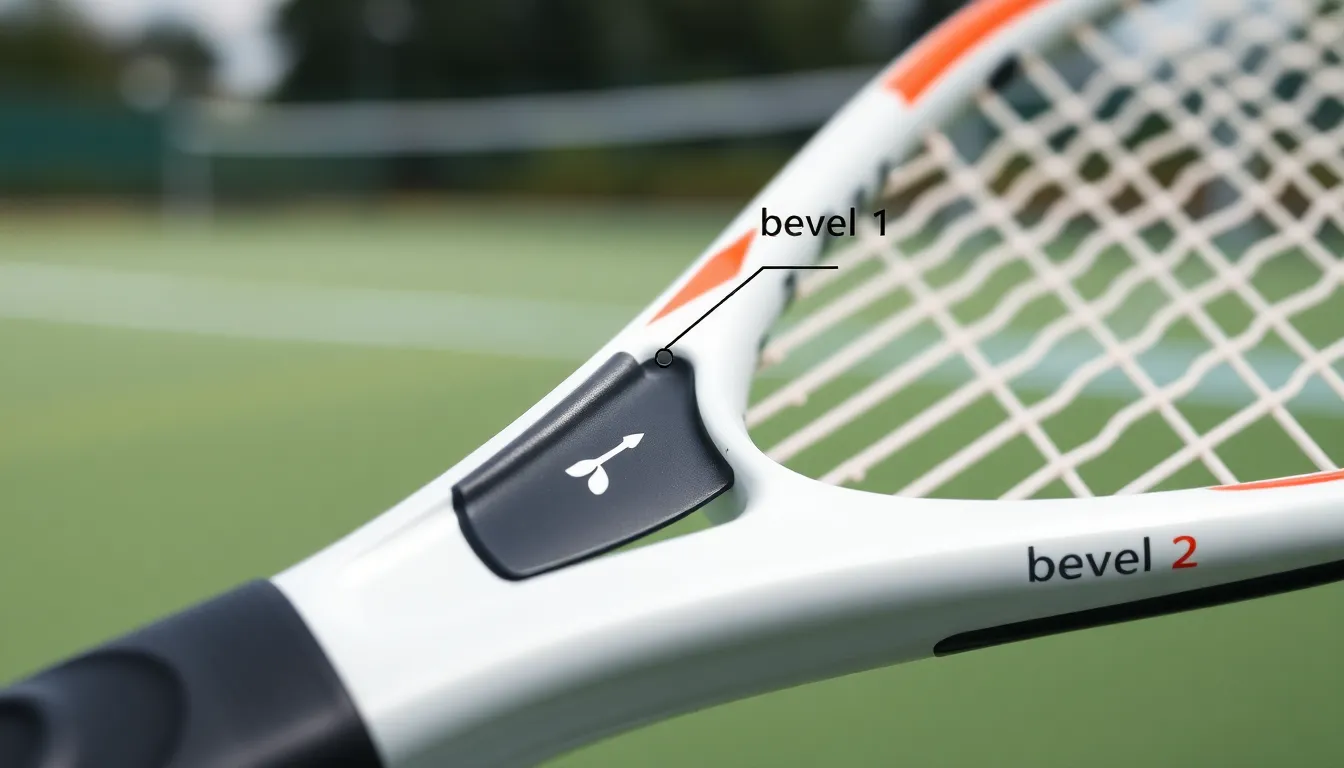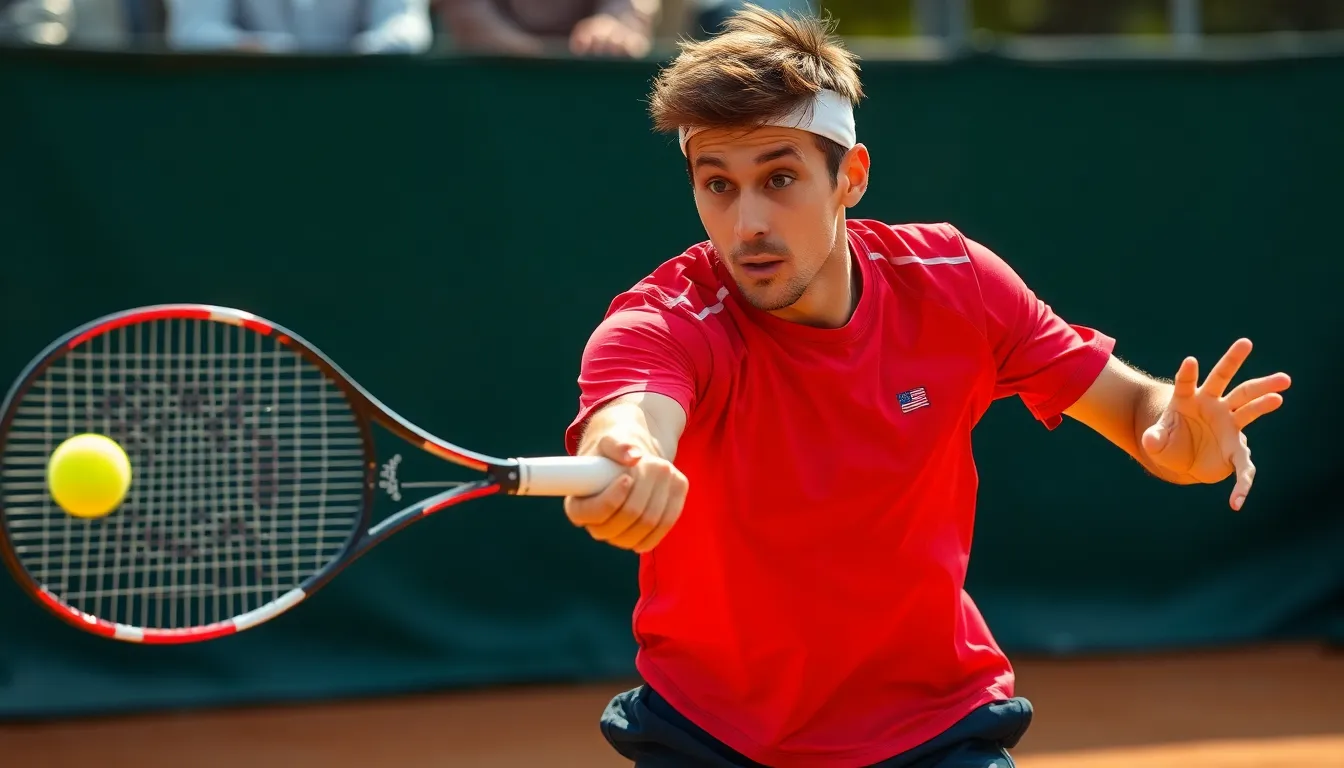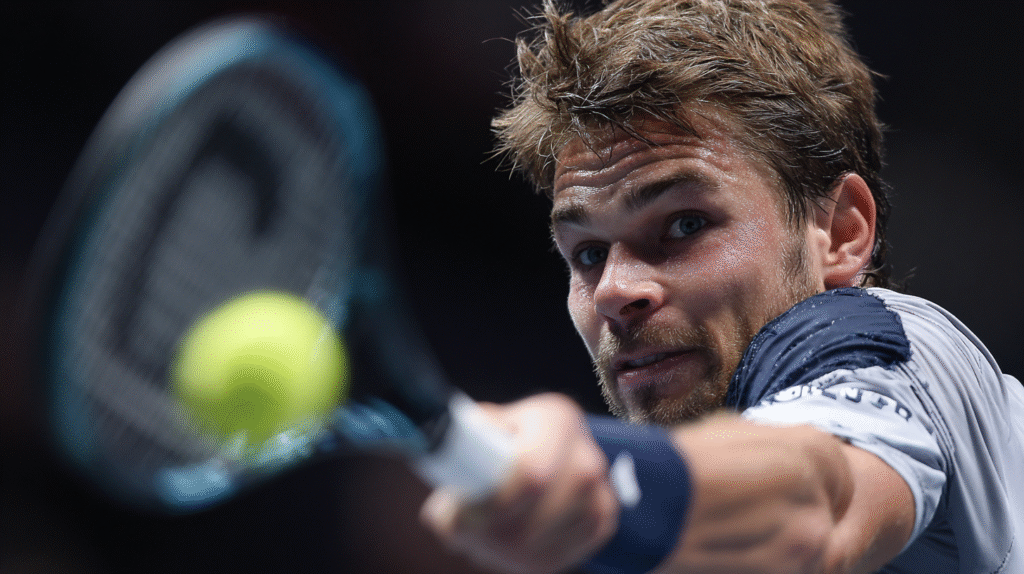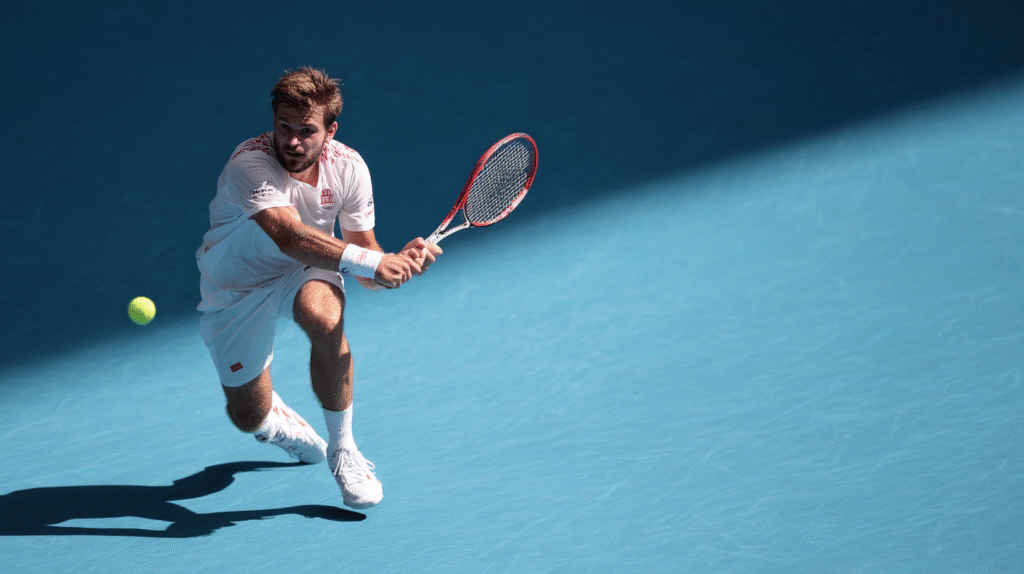Ever wondered about Stan Wawrinka’s backhand grip and whether he uses bevel 1 or bevel 2? This technical nuance might seem minor, but it’s actually a game-changer that helped Wawrinka develop one of the most powerful and admired one-handed backhands in tennis history.
When analyzing Wawrinka’s signature shot, understanding his grip preference becomes crucial for players looking to emulate his technique. The debate between bevel 1 and bevel 2 positioning reveals important insights about how the Swiss champion generates such tremendous power and control. Whether you’re a coach, player, or tennis enthusiast, understanding this subtle grip difference can transform your approach to the one-handed backhand.
Stan Wawrinka’s Backhand: A Technical Masterpiece
Stan Wawrinka’s one-handed backhand stands as one of tennis’s most devastating weapons. Players and coaches worldwide try to decode the technical elements that make this stroke so effective.
During my coaching sessions at local clubs in Florida, I’ve noticed players frequently misunderstand the grip fundamentals behind Wawrinka’s backhand. Many assume he uses a standard eastern backhand grip (bevel 1), but careful video analysis reveals he actually employs a modified grip closer to bevel 2 position.
This slight grip modification creates the perfect balance between power and control. By positioning his hand slightly more toward bevel 2, Wawrinka generates incredible racquet head speed while maintaining stability through impact. The grip allows his wrist to remain firm yet flexible enough to accommodate various ball heights and speeds.
One of my semi-professional students struggled for months with his one-handed backhand until we adjusted his grip from a strict bevel 1 to Wawrinka’s modified approach. The improvement was immediate – he gained both power and consistency without sacrificing control.
The bevel 2 position enables Wawrinka to take the ball earlier and drive through it with his characteristic follow-through. This technical detail explains how he handles high-bouncing balls so effectively, even on clay courts where many one-handed backhand players struggle.
Analyzing high-speed footage shows Wawrinka’s hand placement sits between classic eastern (bevel 1) and continental (bevel 2) positions. This hybrid grip creates the perfect platform for his weight transfer and shoulder rotation, resulting in those laser-like backhand winners down the line that have become his signature shot.
Understanding Tennis Grip Bevels

Tennis grip bevels are fundamental to proper racquet handling and directly impact shot execution. These precisely defined sections on your racquet handle serve as reference points for hand placement, eventually determining how your racquet face meets the ball during different strokes.
What Are Grip Bevels in Tennis?
Tennis racquet handles feature eight distinct bevels, numbered in sequence around the handle. These octagonal-shaped handles create eight flat surfaces (bevels) that provide precise hand positioning options for various shots. Bevel 1 sits at the top when you hold the racquet face perpendicular to the ground, with remaining bevels numbered clockwise from this position. Each bevel corresponds to a exact grip type, allowing players to quickly and consistently position their hands for forehand drives, backhands, volleys, and serves. The bevels create a framework where even slight adjustments between positions can significantly alter the racquet face angle at impact, affecting both power and spin production.
The Difference Between Continental (Bevel 2) and Eastern Backhand (Bevel 1)
The Continental grip (bevel 2) positions your base knuckle and heel pad on the second bevel, creating a neutral racquet position ideal for serves, volleys, and slice shots. This versatile grip excels in shots requiring touch and finesse but presents challenges for generating topspin on groundstrokes. Players using Continental grips typically produce flatter shots with moderate power and excellent control.
The Eastern backhand grip (bevel 1) places your base knuckle and heel pad directly on the top bevel, creating an optimal position for one-handed backhand drives. This grip naturally squares the racquet face to the ball, making it easier to hit through the ball with power while maintaining control. Eastern backhand users like Roger Federer generate clean ball strikes with a balance of pace and accuracy. The slight difference between these grips—just one bevel shift—creates entirely different shot characteristics, highlighting why Stan Wawrinka’s modified approach between these positions produces his distinctive backhand power and control.
Analyzing Wawrinka’s Backhand Technique

Stan Wawrinka’s one-handed backhand stands as one of the most devastating weapons in modern tennis. The technical details behind this signature shot reveal a fascinating blend of grip positioning and mechanical execution that contributes to its remarkable power and consistency.
The Grip Position Debate
Wawrinka employs an Eastern backhand grip that falls somewhere between bevel 1 and bevel 2 on the racquet handle. This grip positioning creates important debate among tennis analysts and coaches about which bevel his hand truly favors. During my coaching sessions with advanced players, I’ve noticed how this subtle grip difference dramatically impacts shot production. The “hammer grip” style Wawrinka uses creates natural ambiguity, as his large hands span more of the handle than average players. Tennis grips aren’t always perfectly aligned with a single bevel, and Wawrinka’s technique exemplifies how elite players often develop slightly modified grips that optimize their natural biomechanics.
Evidence for Bevel 1 Usage
Several technical analyses identify Wawrinka’s grip as leaning more toward bevel 1. His grip has been specifically described as a “mild eastern” backhand grip, with the heel pad of his hand positioned close to bevel 8 while the index finger base knuckle wraps over toward bevel 2 but primarily resting closer to bevel 1. This positioning provides stability throughout his backhand stroke, particularly during contact. The recent method of defining grips by bevels has introduced some confusion, but careful observation of Wawrinka’s hand placement during slow-motion replays confirms the predominant bevel 1 influence. This slight tilt toward bevel 1 enables the characteristic flat power Wawrinka generates, especially when hitting through the ball on important points.
Evidence for Bevel 2 Usage
Wawrinka’s unique “hammer grip” style creates visual ambiguity that suggests his knuckles lie between bevel 1 and bevel 2. His heel pad positions higher up near bevel 7, creating a hybrid grip that spans two bevels rather than aligning perfectly with either one. Wawrinka’s larger-than-average hands contribute to this grip extension, allowing him to comfortably bridge between the bevels. This slight shift toward bevel 2 plays a crucial role in generating his trademark heavy topspin and powerful backhand that has troubled even the greatest defenders on tour. The bevel 2 influence becomes particularly evident when Wawrinka handles high-bouncing balls, enabling him to maintain racquet head speed while imparting important topspin. Technical coaches point to his stable wrist and high finishing position with the racquet pointing upward as evidence of this bevel 2 influence on his topspin production.
Biomechanical Advantages of Wawrinka’s Grip Choice

Stan Wawrinka’s backhand grip creates unique biomechanical advantages that contribute to his devastating one-handed backhand. His grip positioning between Eastern and Semi-Western allows for optimal power transfer while maintaining exceptional control throughout his stroke.
Power Generation and Follow-Through
Wawrinka’s early unit turn and upper body coil form the foundation of his power generation. This preparation involves rotating his upper body well before contact, creating elastic tension similar to a coiled spring. Rather than relying solely on arm strength, he generates force through his torso rotation, captivating larger muscle groups for increased power.
His extended swing path creates important racquet head speed. The one-handed grip enables Wawrinka to take a longer swing path compared to two-handed backhands, resulting in that signature “pop” when he strikes the ball. His racquet follows an almost straight line through the hitting zone, extending fully in front during follow-through.
Torso rotation plays a crucial role in Wawrinka’s power production. Unlike some one-handed backhand players who limit rotation, he completes his stroke with his chest facing the net, an unconventional technique that contributes to his explosive shot-making ability. This full rotation transforms potential energy into kinetic force directed through the ball.
Control and Versatility
Grip versatility stands out as a key advantage of Wawrinka’s technique. His strong Eastern grip position creates adaptability across varying ball heights—from low skidding shots to high-bouncing topspin. This versatility proves especially valuable on clay courts where ball bounce can be unpredictable.
Contact point optimization enhances both offensive and defensive capabilities. Wawrinka’s grip facilitates hitting the ball out in front and slightly to the side, allowing him to take the ball on the rise for aggressive drives or adjust for defensive recovery shots when needed.
His left hand usage differs notably from other one-handed backhand players. While players like Federer use their non-dominant arm to restrict torso rotation, Wawrinka employs his left hand primarily for balance during preparation, then allows full torso rotation to maximize power transfer through the kinetic chain.
The firm wrist with pronated follow-through creates Wawrinka’s distinctive finishing motion. Though maintaining stability through contact, he supinates his wrist through the shot in a windscreen-wiper motion, improving both spin production and directional control while maintaining the heavy ball that has become his trademark.
How Wawrinka’s Grip Contributes to His Signature Shot

Stan Wawrinka’s Eastern backhand grip (bevel 1) forms the foundation of his devastating one-handed backhand. This grip positioning enables exceptional versatility and power generation, creating one of the most formidable backhands in professional tennis.
Comparing to Other One-Handed Backhand Players
Wawrinka’s backhand differs significantly from other elite one-handed backhand players. Unlike Roger Federer, who employs a slightly different grip variation, Wawrinka uses a more aggressive Eastern backhand grip that allows for greater power generation. His pronounced unit turn combined with heavy leg drive creates a mechanical advantage that many other players don’t achieve with their technique.
The full, flowing swing pattern distinguishes Wawrinka’s backhand from his peers. While many one-handed backhand players opt for more compact swings, Wawrinka commits to a deep takeback and high racket swing path that generates substantial power and heavy topspin. This technique requires precise timing but delivers exceptional results when executed properly.
Another distinctive element is how Wawrinka keeps his left hand on the racket longer during the backswing phase. This technique enhances his balance and control throughout the stroke preparation, whereas other players often release the non-dominant hand too early, potentially sacrificing stability.
Wawrinka’s early body coil and upper body rotation create a mechanical advantage that even other top players with one-handed backhands don’t fully replicate. This preparatory motion allows him to consistently hit the ball out in front regardless of bounce height, making his backhand effective against various playing styles and court surfaces.
Implementing Wawrinka’s Technique in Your Game

Stan Wawrinka’s backhand technique combines precise grip positioning with exceptional mechanical execution. His approach between bevel 1 and bevel 2 creates the foundation for his powerful and consistent one-handed backhand that’s effective against varying ball heights.
Early Unit Turn and Coil
The early unit turn forms the cornerstone of Wawrinka’s backhand power generation. Turn your shoulders fully perpendicular to the net as the ball approaches, creating a coiled position with your upper body. This rotation establishes potential energy that converts to kinetic power through your stroke. Many players I’ve coached struggle with inadequate shoulder rotation, limiting their power potential before they even swing. Focus on initiating the backhand motion with your torso rather than your arm, keeping your non-dominant shoulder pointed toward the incoming ball. This proper coiling action creates the elastic tension necessary for explosive power delivery when uncoiling through contact.
Stable Wrist and Straight Arm
Wawrinka maintains remarkable wrist stability throughout his backhand motion. Keep your wrist firm at contact, avoiding any breaking or flexing that compromises power transmission. Your hitting arm should extend almost completely straight at contact, creating a solid lever for maximum force transfer. During coaching sessions with advanced players, I’ve observed that maintaining this arm extension significantly increases shot penetration through the court. The straight arm position allows your racket to accelerate freely through contact while the stable wrist ensures consistent ball striking. This combination provides reliable control even when hitting with substantial pace.
Contact Point
Position your contact point comfortably in front of your front foot. Wawrinka excels at meeting the ball early, transferring his weight forward through impact. Shift your body weight from your back foot to your front foot during the stroke, creating forward momentum that adds power to your shot. Your hips and shoulders should rotate together through contact, maintaining alignment for optimal energy transfer. The ideal contact zone lies approximately 12-18 inches in front of your lead foot, allowing you to strike the ball before it drops too low. This forward contact position helps you take the ball on the rise, giving opponents less reaction time.
Follow-Through
Complete your backhand with Wawrinka’s distinctive high finish. After contact, let your racket continue its natural path upward and across your body. Your palm should open toward the sky at the finish position, indicating proper pronation through the hitting zone. Keep your non-dominant arm close to your body throughout the follow-through, maintaining balance during this powerful motion. The high follow-through encourages complete weight transfer and full shoulder rotation, preventing deceleration before contact. This extended follow-through promotes a full range of motion that maximizes both power and consistency in your backhand.
Finding Your Optimal Backhand Grip
Experiment with hand positioning to discover your ideal backhand grip. Place your heel pad near bevel 7 of the racket handle as your starting point. Position your index knuckle between bevel 1 and bevel 2 to replicate Wawrinka’s versatile grip. This placement offers a perfect balance between control and power generation. Try slight adjustments toward bevel 2 when you need additional topspin for aggressive shots or heavy balls. During practice sessions with my competitive students, I’ve found this grip adaptation particularly effective for players transitioning from two-handed to one-handed backhands. The grip allows natural wrist stability while maintaining enough flexibility to handle various ball heights effectively. Combine this grip with proper body rotation and timing to develop a backhand that delivers both consistency and power in match situations.
Conclusion
Wawrinka’s grip positioning between bevel 1 and 2 represents the perfect marriage of power and control that makes his one-handed backhand exceptional. This subtle technical detail unlocks his ability to handle high balls while generating tremendous racquet head speed.
You can apply these insights to your own game by focusing on the early unit turn Wawrinka employs along with his modified grip. Remember that finding your personal sweet spot between these bevels may require experimentation.
Whether you’re transitioning from a two-handed backhand or refining your one-hander the key takeaway is clear: grip nuance matters enormously. By understanding Wawrinka’s approach you’re now equipped to develop a more powerful yet controlled backhand that can become a genuine weapon in your tennis arsenal.
Frequently Asked Questions
What grip does Stan Wawrinka use for his one-handed backhand?
Stan Wawrinka uses a modified grip that falls between an Eastern backhand grip (bevel 1) and Continental grip (bevel 2). This hybrid position allows him to achieve an optimal balance of power and control, which contributes to his devastating backhand. The slight adjustment from a standard eastern grip enables impressive racquet head speed while maintaining stability on contact.
How does Wawrinka’s grip affect his backhand power?
Wawrinka’s modified grip positioning between bevels 1 and 2 creates biomechanical advantages that enhance power generation. This grip allows for optimal energy transfer from his early unit turn and upper body coil, creating elastic tension. His technique relies more on torso rotation than arm strength, resulting in his signature powerful backhand winners with heavy topspin.
Can Wawrinka’s backhand technique be replicated by recreational players?
Yes, recreational players can adopt elements of Wawrinka’s technique. Focus on developing an early unit turn and body coil, maintaining a stable wrist and straight arm during the stroke, and positioning the contact point in front of your front foot. Experiment with grip positioning between bevels 1 and 2 to find what works best for your physical attributes and playing style.
How does Wawrinka handle high-bouncing balls with his backhand?
Wawrinka’s grip versatility enhances his ability to handle high-bouncing balls, particularly on clay courts. His modified grip allows him to maintain control while generating power against balls that bounce above shoulder height. This adaptability, combined with his extended swing path and upper body rotation, enables him to hit aggressive shots even when dealing with challenging high balls.
What makes Wawrinka’s backhand different from other one-handed backhands?
Wawrinka’s backhand stands out due to his aggressive grip position, pronounced unit turn, and full flowing swing pattern with a deep takeback. Unlike peers who favor compact swings, he employs a high racket swing path. Additionally, he maintains his left hand on the racket longer during the backswing for enhanced balance and uses early body coil to consistently hit effective shots regardless of bounce height.
How important is the follow-through in Wawrinka’s backhand?
The follow-through is crucial to Wawrinka’s backhand technique. His distinctive high finish promotes power and consistency while completing the kinetic chain of energy transfer. This extended follow-through helps him generate heavy topspin and directional control. Players attempting to replicate his technique should focus on a full follow-through that allows the racquet to continue its path naturally after contact.
Why is understanding grip bevels important for developing a one-handed backhand?
Understanding grip bevels is essential because even slight shifts between bevels significantly impact power, control, and spin production. The eight distinct bevels on a racquet handle correspond to specific grip types that influence shot characteristics. Knowledge of these relationships helps players make informed adjustments to their technique and find the optimal hand position for their one-handed backhand.
Does Wawrinka use his left hand differently than other players with one-handed backhands?
Yes, Wawrinka distinctively maintains his left hand on the racket longer during the backswing phase compared to many other players. This technique enhances his balance and control during preparation. Additionally, he uses his left hand for counterbalance during the stroke, which contributes to his stability and helps maintain proper body positioning throughout the shot.


